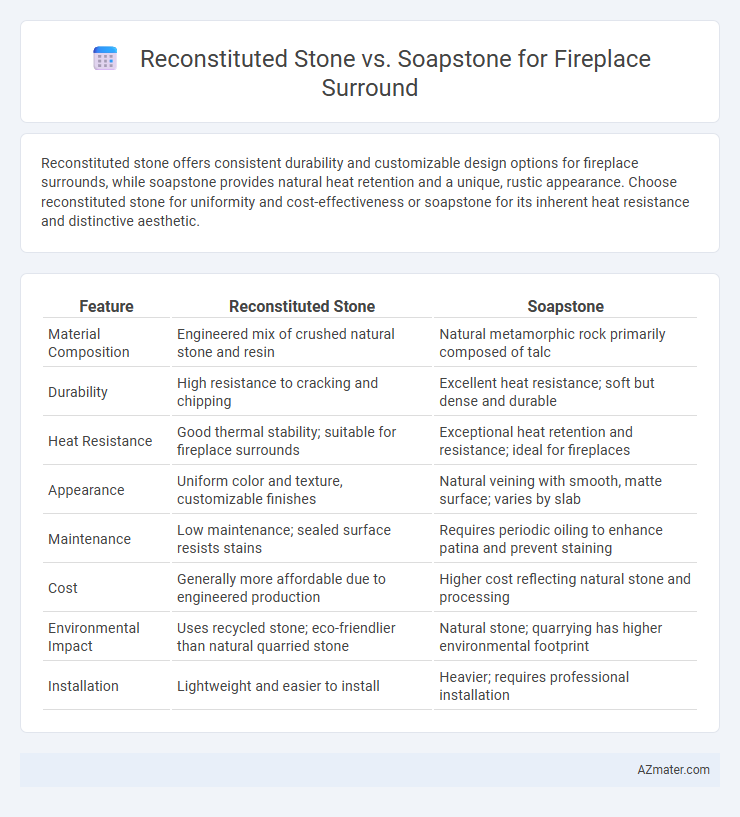Reconstituted stone offers consistent durability and customizable design options for fireplace surrounds, while soapstone provides natural heat retention and a unique, rustic appearance. Choose reconstituted stone for uniformity and cost-effectiveness or soapstone for its inherent heat resistance and distinctive aesthetic.
Table of Comparison
| Feature | Reconstituted Stone | Soapstone |
|---|---|---|
| Material Composition | Engineered mix of crushed natural stone and resin | Natural metamorphic rock primarily composed of talc |
| Durability | High resistance to cracking and chipping | Excellent heat resistance; soft but dense and durable |
| Heat Resistance | Good thermal stability; suitable for fireplace surrounds | Exceptional heat retention and resistance; ideal for fireplaces |
| Appearance | Uniform color and texture, customizable finishes | Natural veining with smooth, matte surface; varies by slab |
| Maintenance | Low maintenance; sealed surface resists stains | Requires periodic oiling to enhance patina and prevent staining |
| Cost | Generally more affordable due to engineered production | Higher cost reflecting natural stone and processing |
| Environmental Impact | Uses recycled stone; eco-friendlier than natural quarried stone | Natural stone; quarrying has higher environmental footprint |
| Installation | Lightweight and easier to install | Heavier; requires professional installation |
Introduction to Fireplace Surround Materials
Reconstituted stone offers a versatile and cost-effective option for fireplace surrounds, combining crushed natural stone with resin binders to mimic the appearance of natural stone while providing enhanced durability and uniformity. Soapstone, renowned for its heat retention and smooth texture, is a dense, natural metamorphic rock that resists cracking and heat damage, making it a traditional choice for fireplaces. Selecting between reconstituted stone and soapstone depends on factors such as budget, aesthetic preference, and maintenance requirements for a fireplace surround.
What is Reconstituted Stone?
Reconstituted stone is a man-made material crafted from crushed natural stone combined with resins and pigments, offering a durable and customizable alternative to natural stone for fireplace surrounds. Unlike soapstone, which is a naturally occurring metamorphic rock known for its heat retention and smooth texture, reconstituted stone provides consistent color and pattern options tailored to specific design needs. Its engineered composition ensures enhanced strength, ease of installation, and resistance to staining and heat, making it a practical choice for modern fireplace applications.
What is Soapstone?
Soapstone is a natural metamorphic rock composed primarily of talc, known for its heat retention and durability, making it ideal for fireplace surrounds. Its smooth, soft texture allows for intricate carving and a unique, warm appearance that darkens over time with use. Compared to reconstituted stone, soapstone offers superior thermal mass, absorbing and slowly releasing heat, which enhances fireplace efficiency.
Aesthetic Differences: Reconstituted Stone vs Soapstone
Reconstituted stone offers a wide range of colors and textures that can mimic natural stone varieties, providing versatile aesthetic options for fireplace surrounds. Soapstone features a smooth, matte finish with subtle veining, creating a timeless, warm look that naturally darkens with age. The choice between reconstituted stone and soapstone ultimately depends on preference for the engineered uniformity and color variety of reconstituted stone versus the organic, tactile appeal of natural soapstone.
Durability and Heat Resistance Comparison
Reconstituted stone offers enhanced durability due to its engineered composition, which resists cracking and chipping better than natural soapstone. Soapstone excels in heat resistance, with a natural ability to absorb and radiate heat evenly, making it ideal for fireplace surrounds. While reconstituted stone combines strength with moderate heat tolerance, soapstone remains superior for sustained high-temperature exposure without degradation.
Maintenance and Cleaning Requirements
Reconstituted stone fireplace surrounds demand periodic sealing to prevent stains and require non-abrasive cleaners, while soapstone is naturally resistant to acids and stains, needing only mild soap and water for maintenance. Soapstone develops a patina over time, enhancing its appearance with minimal upkeep compared to the occasional resealing and careful cleaning reconstituted stone surfaces require. Both materials benefit from regular dusting, but soapstone's dense structure reduces the likelihood of dirt penetration, making it a lower-maintenance option for fireplace surrounds.
Cost Analysis: Reconstituted Stone vs Soapstone
Reconstituted stone offers a more cost-effective option for fireplace surrounds, typically priced between $30 to $60 per square foot, compared to soapstone, which ranges from $70 to $120 per square foot due to its natural origin and durability. Installation costs for reconstituted stone are generally lower, as the material is lighter and easier to work with, reducing labor expenses. While soapstone provides superior heat resistance and longevity, its higher upfront cost makes reconstituted stone a practical choice for budget-conscious homeowners seeking aesthetic appeal and functionality.
Environmental Considerations
Reconstituted stone for fireplace surrounds is often praised for its sustainable production process, utilizing recycled stone aggregates and less quarrying activity, which reduces environmental impact. Soapstone, while naturally quarried and known for durability and heat retention, involves more intensive extraction practices that can lead to habitat disruption and higher carbon emissions. Choosing reconstituted stone supports eco-friendly building goals by minimizing resource depletion and reducing waste commonly associated with natural stone extraction.
Installation Process and Complexity
Reconstituted stone for fireplace surrounds offers a streamlined installation process due to its consistent size, lightweight composition, and ability to be cut with standard tools, reducing labor time and complexity. Soapstone, being a natural stone, requires specialized cutting tools and careful handling to avoid damage, making installation more labor-intensive and complex. The uniformity of reconstituted stone panels often allows for easier fitting and fewer variations during installation compared to the irregularities found in soapstone slabs.
Which Material is Best for Your Fireplace Surround?
Reconstituted stone offers greater durability and a wider range of color options for fireplace surrounds, making it ideal for homeowners seeking a customizable and low-maintenance solution. Soapstone, valued for its natural heat retention and unique veining, provides a timeless aesthetic and excellent thermal properties that gradually radiate warmth. Choosing between reconstituted stone and soapstone depends on whether you prioritize customization and durability or natural beauty and heat retention for your fireplace surround.

Infographic: Reconstituted stone vs Soapstone for Fireplace Surround
 azmater.com
azmater.com